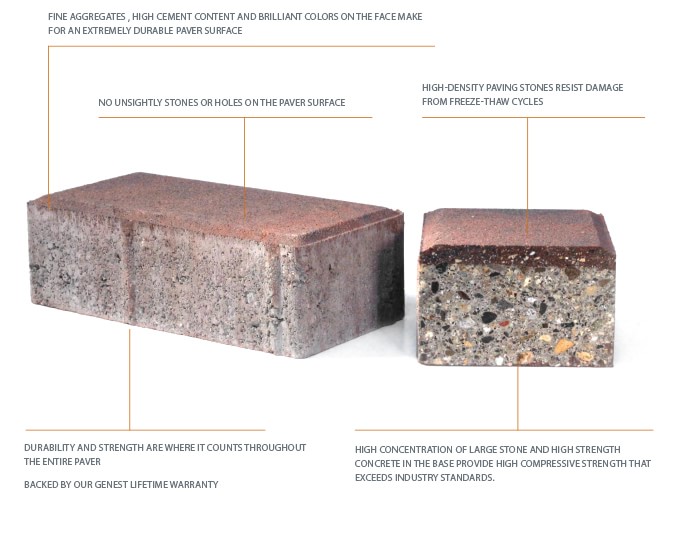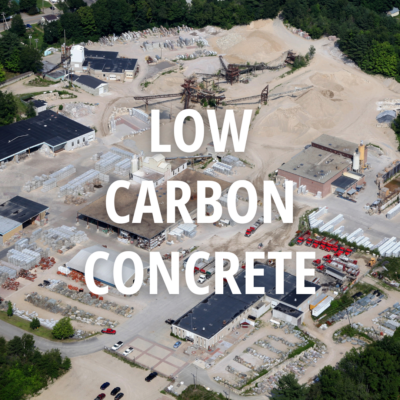As landscapers and hardscapers, you’ve always been connected to the environment and can see your impact on it in your everyday work. But beyond the individual retaining walls, patios, and flower beds, the collective building industry has an immense impact on our environment.
Amidst a growing body of science highlighting the ecological impacts of traditional building practices, forward-thinking manufacturers like Genest are stepping up, pioneering innovative products that promise more sustainable construction practices. In this blog, we’ll discuss how integral concrete is to our built environment and the footprint concrete production leaves on the natural world. Then we’ll talk about the introduction of low carbon concrete and how this shift isn’t just a trend, but a necessary evolution to ensure our buildings and landscapes are thriving today and tomorrow.
History of Concrete
 The story of concrete manufacturing is as old as civilization itself, with its origins tracing back to ancient times when natural cement compounds were discovered and utilized in buildings. The Romans perfected the use of concrete, evidenced by enduring structures like the Pantheon, with its magnificent 142-foot concrete dome withstanding more than 2,000 years of earthquakes, storms, and other natural disasters. Over time, concrete’s popularity burgeoned and its recipe was refined during the Industrial Revolution with the invention of Portland cement, giving rise to the robust material we know today.
The story of concrete manufacturing is as old as civilization itself, with its origins tracing back to ancient times when natural cement compounds were discovered and utilized in buildings. The Romans perfected the use of concrete, evidenced by enduring structures like the Pantheon, with its magnificent 142-foot concrete dome withstanding more than 2,000 years of earthquakes, storms, and other natural disasters. Over time, concrete’s popularity burgeoned and its recipe was refined during the Industrial Revolution with the invention of Portland cement, giving rise to the robust material we know today.
Modern concrete is a testament to innovation, composed of a mix of aggregates bonded together with cement and water. This fundamental triad of concrete ingredients has been the foundation for skyscrapers, highways, homes, sidewalks, patios, and more, underscoring concrete’s integral role in our built environment. Now, more than 4 billion tons of concrete are produced each year and aside from water, it is the most consumed material in the world. Its ascendance as the material of choice for construction is due to its unparalleled compressive strength, durability, and ability to take any shape when wet, solidifying into a rock-hard structure that withstands the test of time.
Why is Concrete Important to Current Construction Practices?
Concrete’s importance in construction practices is undeniable. As a material, concrete’s inherent characteristics of strength and versatility make it indispensable for both commercial and residential buildings. Its ability to withstand immense pressure makes it the material of choice for foundations, high-rise buildings, bridges, and countless other structures that shape our urban landscape. Concrete’s thermal mass contributes to energy efficiency in buildings and its resistance to fire enhances safety.
Its durability makes also it a practical choice for high traffic areas around the home like patios, driveways, and walkways. Plus, it readily withstands harsh New England weather conditions to ensure outdoor living spaces are beautiful and long-lasting. It can be made in a variety of colors, shapes, and sizes to achieve a look unique to every home.
However, traditional concrete manufacturing does come with a significant carbon footprint, mainly due to the cement production process. The processing of cement accounts for 75% of total carbon emissions by traditionally manufactured concrete. As we consider the future of concrete production, there is an urgent need for more sustainable solutions.
G-Mix: A Low Carbon Concrete
Since 1985, Genest has been using less cement in concrete paving stone production than most paving stone producers, therefore offering local hardscape professionals and homeowners an option for reduced carbon concrete. Now, we’re proud to offer G-Mix, a new formula for low carbon concrete that is the first of its kind in the industry. There are a few key factors that make G-Mix a more sustainable concrete solution:
Less Cement: Cement has long been the binding agent of choice for most concrete production, but Genest has cut the use of cement in G-Mix by 50% by replacing it with slag, a byproduct from the steel industry. Not only does this reduce the cement (and therefore carbon) needed to manufacture the concrete, but it also increases the strength of the finished product and provides practical use for an existing waste stream.
Recycled Content: All G-mix formulas use at least 5% recycled content and some G-mix formulas for CMU and Comfort Block use up to 55% foamed recycled glass aggregate. Less new material created means less carbon released in concrete manufacturing.
Keeping it Local: We source our aggregate locally, and sell to local hardscape and landscape professionals, meaning both materials and the finished low carbon concrete products travel shorter distances and produce less CO2 emissions along the way. Plus, we love supporting our local Maine economy and are excited to create a system that diverts waste and helps create beautiful outdoor spaces for our neighbors.
 Not only is low carbon concrete better for the environment, G-Mix also exceeds ASTM strength requirements and has improved color and decreased efflorescence. Our full line of manufactured stone and concrete pavers is produced using G-Mix so you can be confident in choosing a high-quality and more sustainable concrete product in your next project. Our products are subject to ongoing, continual improvement as we challenge our materials and processes, pushing the boundaries of concrete manufacturing and what it means to support sustainable construction practices.
Not only is low carbon concrete better for the environment, G-Mix also exceeds ASTM strength requirements and has improved color and decreased efflorescence. Our full line of manufactured stone and concrete pavers is produced using G-Mix so you can be confident in choosing a high-quality and more sustainable concrete product in your next project. Our products are subject to ongoing, continual improvement as we challenge our materials and processes, pushing the boundaries of concrete manufacturing and what it means to support sustainable construction practices.
While the role of concrete manufacturers, like Genest, is pivotal to changing the building materials available and shifting the industry, it’s worth emphasizing the collective impact we can all have on paving the way for a more sustainable future. Individual landscapers, builders, and homeowners each hold the power to make environmentally conscious choices that, when aggregated, herald a significant shift towards sustainable living.
By choosing materials such as G-Mix for projects, professionals in the field are not just constructing with superior products, they are also contributing to a larger movement of ecological stewardship. Homeowners opting for such materials are investing in homes that stand the test of time, both structurally and environmentally. Genest invites you to be part of this shift, where each selection of stone, each paver laid, becomes a commitment to our planet’s future. You can learn more about our G-Mix formula and the low carbon concrete products available near you in our 2024 catalog.




